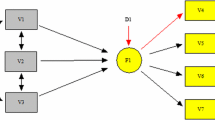Abstract
Suppose a collection of standard tests is given to all subjects in a random sample, but a different new test is given to each group of subjects in nonoverlapping subsamples. A simple method is developed for displaying the information that the data set contains about the correlational structure of the new tests. This is possible to some extent, even though each subject takes only one new test. The method uses plausible values of the partial correlations among the new tests given the standard tests in order to generate plausible simple correlations among the new tests and plausible multiple correlations between composites of the new tests and the standard tests. The real data example included suggests that the method can be useful in practical problems.
Similar content being viewed by others
Reference Note
Beaton, A. E.The use of special matrix operations in statistical calculus. (ETS RB-64-51). Princeton, N. J.: Educational Testing Service, 1964.
References
Anderson, T. W. Maximum likelihood estimates for a multivariate normal distribution when some observations are missing.Journal of the American Statistical Association, 1957,52, 200–203.
Dempster, A. P.Elements of Continuous Multivariate Analysis. Reading, Mass.: Addison-Wesley Publishing Company, 1969.
Edgett, G. L. Multiple regression with missing observations among the independent variables.Journal of the American Statistical Association, 1956,51, 122–131.
Hartley, H. O. & Hocking, R. R. The analysis of incomplete data.Biometrics, 1971,27, 783–823.
Lord, F. M. Equating test scores—A maximum likelihood solution.Psychometrika, 1955,20, 193–200. (a)
Lord, F. M. Estimation of parameters from incomplete data.Journal of the American Statistical Association, 1955, 50, 870–876. (b)
Lord, F. M. & Novick, M. R.Statistical theories of mental test scores. Reading, Mass.: Addison-Wesley Publishing Company, 1968.
Rubin, D. B. Characterizing the estimation of parameters in incomplete-data problems.Journal of the American Statistical Association, 1974,69, 467–474.
Rubin, D. B. Comparing regressions when some predictor values are missing.Technometrics, 1976,18, 201–205. (a)
Rubin, D. B. Inference and missing data.Biometrika, 1976,63, 581–592. (b)
Author information
Authors and Affiliations
Rights and permissions
About this article
Cite this article
Rubin, D.B., Thayer, D. Relating tests given to different samples. Psychometrika 43, 3–10 (1978). https://doi.org/10.1007/BF02294084
Received:
Revised:
Issue Date:
DOI: https://doi.org/10.1007/BF02294084




